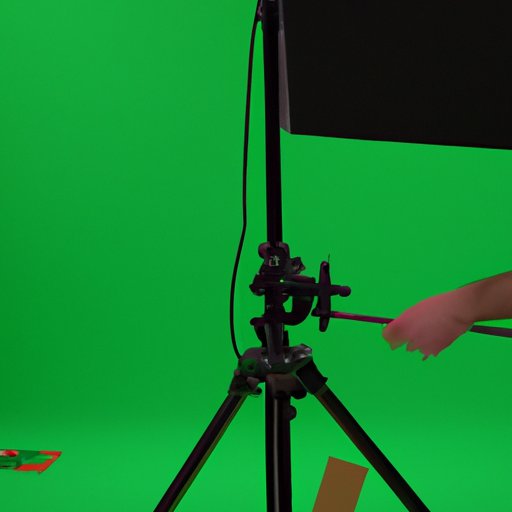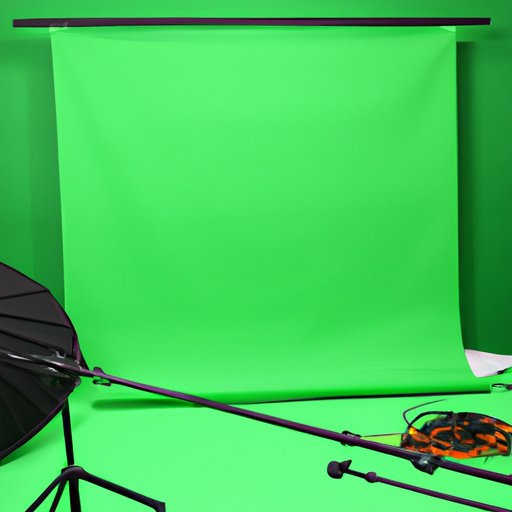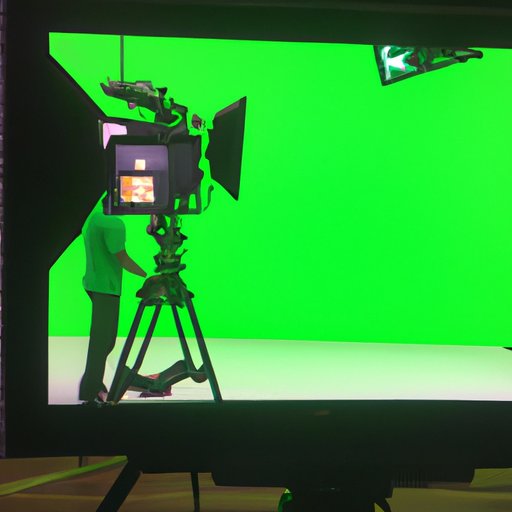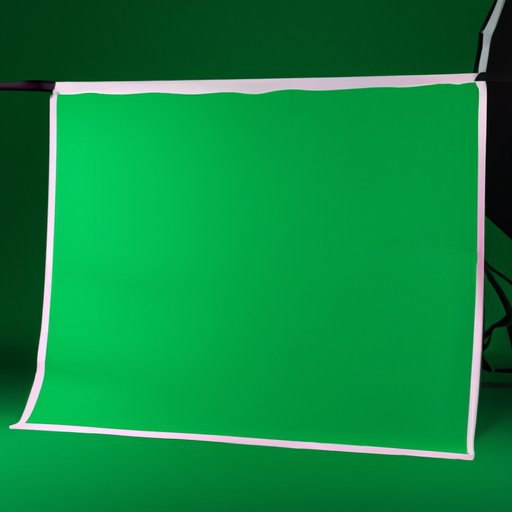Introduction
Green screen technology has been around for decades, used in everything from Hollywood blockbusters to local news broadcasts. But what exactly is a green screen, and how does it work? In this article, we’ll explore the basics of green screen technology and how to use it to create professional quality visual effects.

Definition of Green Screen Technology
A green screen (also known as chroma key) is a special effects technique that allows filmmakers and video producers to superimpose one image or video clip over another. The green screen is used as a backdrop behind the subject, and then replaced with a different image or video clip during post-production editing.
Overview of Applications
Green screen technology is used in a variety of industries, from film production to broadcast journalism. It can be used to create realistic backgrounds for movies and TV shows, composite multiple shots into a single scene, and even add special effects like explosions and flying objects. It’s also commonly used in news broadcasts, where reporters stand in front of a green screen and are superimposed onto a virtual set.

Exploring the Mechanics Behind a Green Screen Setup
Before you can start creating professional quality visual effects with a green screen, it’s important to understand the mechanics behind the setup. Let’s take a look at the components of a green screen setup, as well as the process of chroma keying.
Understanding Chroma Keying
Chroma keying (also known as color keying) is the process of replacing a solid color in an image or video clip with another image or video clip. This is done by filming the subject in front of a green screen, and then using software to replace the green background with a different image or video clip. To achieve a convincing effect, the green screen should be evenly lit and free of shadows or wrinkles.
Different Types of Green Screens and Their Benefits
There are several types of green screens available, each with their own benefits. For example, cloth green screens are lightweight, portable, and easy to set up. However, they are not as durable as other types of green screens and may require frequent replacement. On the other hand, vinyl green screens are more durable and provide better color accuracy, but they are heavier and more difficult to transport. Ultimately, the type of green screen you choose will depend on your specific needs.

Components of a Green Screen Setup
In addition to the green screen itself, there are several other components required for a successful green screen setup. These include lighting equipment, a camera, and software for post-production editing. When choosing lighting equipment, it’s important to select lights that are powerful enough to evenly light the entire green screen without casting any shadows. Additionally, the camera should be capable of capturing high-quality footage and should be positioned at a distance that allows the entire green screen to be in frame. Finally, post-production editing software is necessary to composite the footage and replace the green screen with a different image or video clip.
How to Create Professional Quality Visual Effects with a Green Screen
Now that you understand the basics of green screen technology, let’s take a look at how to create professional quality visual effects with a green screen. Here are the steps involved in setting up and capturing green screen footage:
Pre-Production Preparation
The first step in creating professional quality visual effects with a green screen is pre-production preparation. This includes selecting the right green screen and lighting equipment, positioning the camera correctly, and making sure the actors and crew are aware of the setup. Additionally, it’s important to make sure the green screen is wrinkle-free and evenly lit before filming begins.
Setting Up the Green Screen
Once the pre-production preparation is complete, it’s time to set up the green screen. This involves positioning the green screen so that it fills the frame, setting up the lighting equipment, and adjusting the camera settings. Additionally, it’s important to make sure the green screen is evenly lit and free of shadows or wrinkles.

Capturing the Green Screen Footage
Once the green screen is set up, it’s time to capture the footage. This involves filming the subject in front of the green screen while maintaining proper exposure and focus. It’s important to make sure the entire green screen is in frame, and that the footage is captured in a way that allows for easy post-production editing.
Post-Production Editing
The final step in creating professional quality visual effects with a green screen is post-production editing. This involves using software to composite the footage and replace the green screen with a different image or video clip. This process can be time-consuming, so it’s important to plan ahead and be patient.
A Step-by-Step Guide to Using a Green Screen for Video Production
Using a green screen for video production is a great way to create professional quality visual effects. Here is a step-by-step guide to using a green screen for video production:
Pre-Production Preparation
Select the right green screen and lighting equipment, position the camera correctly, and make sure the actors and crew are aware of the setup. Additionally, make sure the green screen is wrinkle-free and evenly lit before filming begins.
Setting Up the Green Screen
Position the green screen so that it fills the frame, set up the lighting equipment, and adjust the camera settings. Additionally, make sure the green screen is evenly lit and free of shadows or wrinkles.
Capturing the Footage
Film the subject in front of the green screen while maintaining proper exposure and focus. Make sure the entire green screen is in frame, and that the footage is captured in a way that allows for easy post-production editing.
Post-Production Editing
Use software to composite the footage and replace the green screen with a different image or video clip. This process can be time-consuming, so it’s important to plan ahead and be patient.
Conclusion
Green screen technology is a powerful tool for creating professional quality visual effects. By understanding the basics of green screen technology, such as chroma keying and the components of a green screen setup, you can create stunning visuals with minimal effort. With the right preparation and post-production editing, you can create amazing visuals with a green screen.
Summary of Key Points
In this article, we explored the basics of green screen technology and how to use it to create professional quality visual effects. We discussed the definition of green screen technology, the components of a green screen setup, and how to create professional quality visual effects with a green screen. We also provided a step-by-step guide to using a green screen for video production.
Final Thoughts
Green screen technology is a powerful tool for creating professional quality visual effects. With the right preparation and post-production editing, you can create stunning visuals with a green screen. So if you’re looking to take your video production to the next level, consider investing in a green screen setup.
(Note: Is this article not meeting your expectations? Do you have knowledge or insights to share? Unlock new opportunities and expand your reach by joining our authors team. Click Registration to join us and share your expertise with our readers.)
